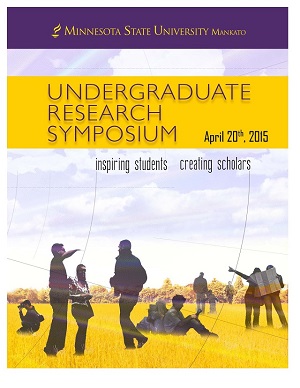Analyzing Interaction Between Two Proteins Related to Crohn’s
Location
CSU Ballroom
Start Date
20-4-2015 10:00 AM
End Date
20-4-2015 11:30 AM
Student's Major
Biological Sciences
Student's College
Science, Engineering and Technology
Mentor's Name
Kelly Grussendorf
Mentor's Email Address
kelly.grussendorf@mnsu.edu
Mentor's Department
Biological Sciences
Mentor's College
Science, Engineering and Technology
Description
About 700,000 Americans suffer from Crohn’s disease, which has no cure, stressing the importance of research. Studies have found the gene, IRGM to be mutated in many individuals with Crohn’s disease. IRGM plays a role in the removal of harmful bacteria through autophagy. Another protein, CRIP was found in rats to play a role in the movement of materials within the intestinal tract as well as destroying foreign material, in a fashion much like autophagy. The homologue of IRGM within Caenorhabditis elegans, binds to the homolog protein, CRIP. We are conducting research to identify whether IRGM and CRIP proteins interact within the model organism mice. We hypothesized that an interaction between the CRIP and IRGM protein will occur in mice because we see such interactions of the homologous proteins in C. elegans. We wanted to analyze the possible interaction in mice, with the goal of finding a connection to Crohn’s disease. The yeast-two hybrid method was used to determine whether CRIP and IRGM proteins interact. The RNA of our genes of interest we have isolated were converted into DNA through the process of reverse transcriptase, then were amplified through Polymerase Chain Reaction. We incorporated our DNA into yeast using DNA vectors so that our proteins of interest could be synthesized. We then analyzed our yeast plates to determine if protein –protein interactions occurred. The results of this study will give us a better understanding of Crohn’s, contributing to the overall goal of for finding a treatment.
Analyzing Interaction Between Two Proteins Related to Crohn’s
CSU Ballroom
About 700,000 Americans suffer from Crohn’s disease, which has no cure, stressing the importance of research. Studies have found the gene, IRGM to be mutated in many individuals with Crohn’s disease. IRGM plays a role in the removal of harmful bacteria through autophagy. Another protein, CRIP was found in rats to play a role in the movement of materials within the intestinal tract as well as destroying foreign material, in a fashion much like autophagy. The homologue of IRGM within Caenorhabditis elegans, binds to the homolog protein, CRIP. We are conducting research to identify whether IRGM and CRIP proteins interact within the model organism mice. We hypothesized that an interaction between the CRIP and IRGM protein will occur in mice because we see such interactions of the homologous proteins in C. elegans. We wanted to analyze the possible interaction in mice, with the goal of finding a connection to Crohn’s disease. The yeast-two hybrid method was used to determine whether CRIP and IRGM proteins interact. The RNA of our genes of interest we have isolated were converted into DNA through the process of reverse transcriptase, then were amplified through Polymerase Chain Reaction. We incorporated our DNA into yeast using DNA vectors so that our proteins of interest could be synthesized. We then analyzed our yeast plates to determine if protein –protein interactions occurred. The results of this study will give us a better understanding of Crohn’s, contributing to the overall goal of for finding a treatment.
Recommended Citation
Opoku Akyeampong, Kwame and Garret Fitzsimmons. "Analyzing Interaction Between Two Proteins Related to Crohn’s." Undergraduate Research Symposium, Mankato, MN, April 20, 2015.
https://cornerstone.lib.mnsu.edu/urs/2015/poster_session_A/28




